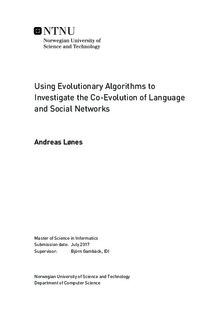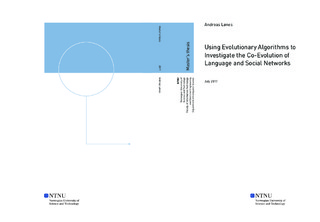| dc.description.abstract | Scientists have been researching how human language evolved into the complex language it is today for a long time. This is a difficult task because no historical data has been discovered concerning the earliest forms of human communication. In recent years, computer scientists have attempted to simulate language evolution using computational models.
This thesis will continue the work of using computer simulations to investigate the effects cultural, biological, and social evolution have on language evolution. Four state-of-the-art computational models are discussed: Lipowska(2011), Lekvam(2014), Gong(2011), and Munroe and Cangelosi(2002).
The computational model designed for this thesis has mainly been inspired by Lekvam's work, which used genetic algorithms to simulate the co-evolution of language and social structure. In order to further investigate the effects of cultural and biological evolution, the new model has a redesigned fitness function, an alternative method of calculating the weight of a word, and an original design of the genome. The genome was designed based on the theory of $10$ basic human values which was formulated by Schwartz(1992). This theory claims that a person's personality is defined by the values that person has.
The experiments show that parts of the computational model worked as intended. The results indicate that mostly acting introvertly is beneficial compared to an extrovert strategy, that the first years are crucial when it comes to an agent's language, and that language evolution to a certain extent is influenced by the Baldwin effect. However, there are some simplifications that simply cannot be ignored. The naming game is an overly-simplification of human language that might lead the simulations to reach one common language too quickly. Furthermore, the simulated social network does not properly depict the evolution of a social structure because there are no geographical distances between the individuals. This leads to the social network becoming one large network too quickly, which in turn aids the simulation in quickly reaching one common language.
This research has contributed some new ideas that seem to work as intended and brought new issues into the light. With future work being put into researching language games and how social networks affect language evolution, it could bring us one step closer to understanding how human language evolved. | |

